Creating an ecommerce site means taking a series of fundamental steps such as choosing the most suitable platform for your needs, registering a domain, taking care of the design and architecture of the site and optimizing it for search engines.
Starting an online business also requires preliminary steps such as deciding what products to sell, knowing the market in which you want to enter, knowing the tax aspects of the business and having the necessary budget. More details about the above mentioned aspects are available in our in-depth guide to ecommerce.
In this article, Create an commerce website: the complete guide, we will focus on aspects related specifically to the creation of an ecommerce site. Firstly, let’s see why it’s worth creating an ecommerce site.
Table of Contents
Why create an ecommerce website
The ecommerce market is steadily growing and online retail is gaining momentum. Needless to say in 2020, online retail sales accounted for 18% of total retail sales. Numbers that are set to grow, as sales are expected to increase to 21.8% by 2024.
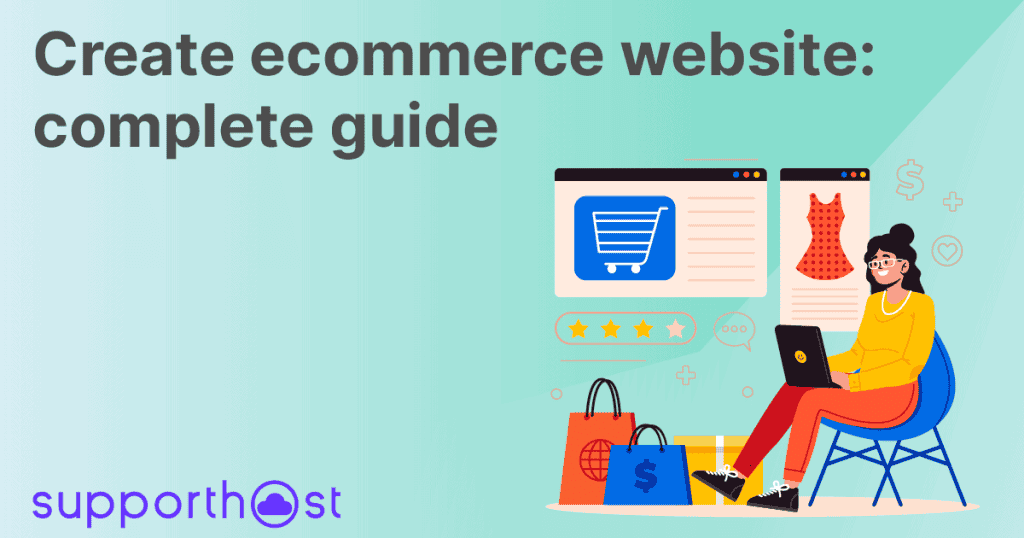
If the growing numbers are not enough to explain why it makes more sense to create an ecommerce nowadays, let’s look at the advantages of selling online.
Extend your reach
Creating an ecommerce site allows you to reach customers interested in your product anywhere in the world. You’d find an amount of buyers that you could never reach just with one or more physical stores that by their very nature are limited.
Strengthen your brand identity
When we talk about selling online we can rely on different channels. An example is to create your own store within a platform that is already established and known as a marketplace.
Of course, there are substantial differences between choosing to lean on a marketplace and creating your own ecommerce site.
With an ecommerce, the management is more complex, but you gain autonomy. You can choose how to advertise your ecommerce, you can customize every aspect, in a nutshell you establish your own rules.
But, above all, the biggest advantage is the absence of direct competition. Different retailers are grouped together on marketplaces, and when you sell similar products, you risk seeing sales slip through the cracks.
Furthermore, even when you do manage to sell, the risk is that the customer has no real awareness of who is selling the goods. The result is that customers don’t remember the brand and the company, only the marketplace where they are making the purchase. This means that the brand inevitably ends up in the background.
Conversely, however, creating your own ecommerce site can make all the difference in growing your brand awareness.
Guiding the consumer through the customer journey
Creating an ecommerce site allows you to get to know your customers better and intercept their interests. You can use the information you gather about your potential customers to accompany and influence their decision-making process that leads them to make a purchase, what is often referred to as the customer journey.
Remember that this process is about the consumer’s experience and interaction with the company. The customer journey can be identified by a few key stages.
The journey begins with the so-called awareness. The consumer, in order to satisfy a need, becomes aware of the existence of a product and, more generally, of a brand.
This phase is followed by the careful evaluation of the purchase, or consideration, the consumer then searches for more information and selects the most suitable product for his/her needs.
You then arrive at the actual purchase, the phase that can be defined as a decision or conversion. It should be noted that you don’t always get to this stage because there are a whole series of factors that can also compromise the purchase.
An example can be when the customer’s preferred payment method is not available, he/she then, turns to another online sales site to fulfill their needs.

Or the potential customer realizes the presence of costs that he/she had not anticipated. The most common case is when, after adding the products to the cart, the come across shipping costs.
For these and various other reasons, get used to the idea that creating an ecommerce site also means having to deal with the problem of abandoned shopping carts. Luckily, however, even in this case the analysis will help you.
You can track user behavior on your site, understand at what point the path to purchase breaks down, and what methods to use to retrieve these possible buyers.
You’ll need to act on multiple channels: first, improving the user experience and eliminating common problems. For example, you may find that you need to simplify payment procedures and make the site registration process required to complete the purchase less complicated.
On the other hand, you can create email reminders to incentivize them to finalize the purchase.
Conversion, however, is not the last step in the purchase journey. The desirable next step is loyalty. A customer who has purchased one of your products is satisfied with the sales process, the support after the purchase and the product itself.
After capturing the customer’s interest to the point of conversion there is another even more difficult step to take: trust. The customer decides that the brand is still worth their attention and thus becomes a repetitive customer.
How do you make the customer journey result in conversion? By analyzing user behavior on your site.
You can’t just set up an ecommerce site and wait for the products to sell themselves. You’ll need to be clear in your mind about your goals, read up on potential customers, and figure out which touch points to leverage to communicate with them.
Knowing your customers and being able to empathize with them will allow you to accompany them on the path to purchase until the final decision, instead of trying to force them in that direction.
Create an ecommerce website: advantages and disadvantages for buyers
In the light of what we have seen, creating an ecommerce site is an opportunity to be seized both by brands that want to expand their customer base by combining physical stores with an online storefront and for those who approach online sales for the first time.
And from the buyers’ point of view, however, what are the advantages and disadvantages of relying on online sales?
For buyers, relying on online sales means convenience, affordability and a wide range of choices.

Comfort because shopping can be done literally anytime and anywhere more and more purchases are also being made directly from the mobile phone.
Convenience because you have the ability to select offers and promotions due to the wide range of alternatives.
However, creating an ecommerce site also hides disadvantages that are worth dwelling on, i.e. reasons why shoppers are wary of buying online.
Among the negative aspects there is the limitation of not being able to physically touch the products you are buying.
In order to fix this, the seller can try to make up for this by taking care of the description of the products, not leaving out the technical specifications and especially trying to show the product as much as possible through photos.
Another disadvantage is given by the lack of sales staff who can guide the customer in the choice. Also in this case you can take cover by setting up a chat system that allows you to assist customers in real time during purchases and answer any questions.
Finally, there is still a large proportion of users who do not trust online sales sites. This mistrust generally concerns the security of online payments.
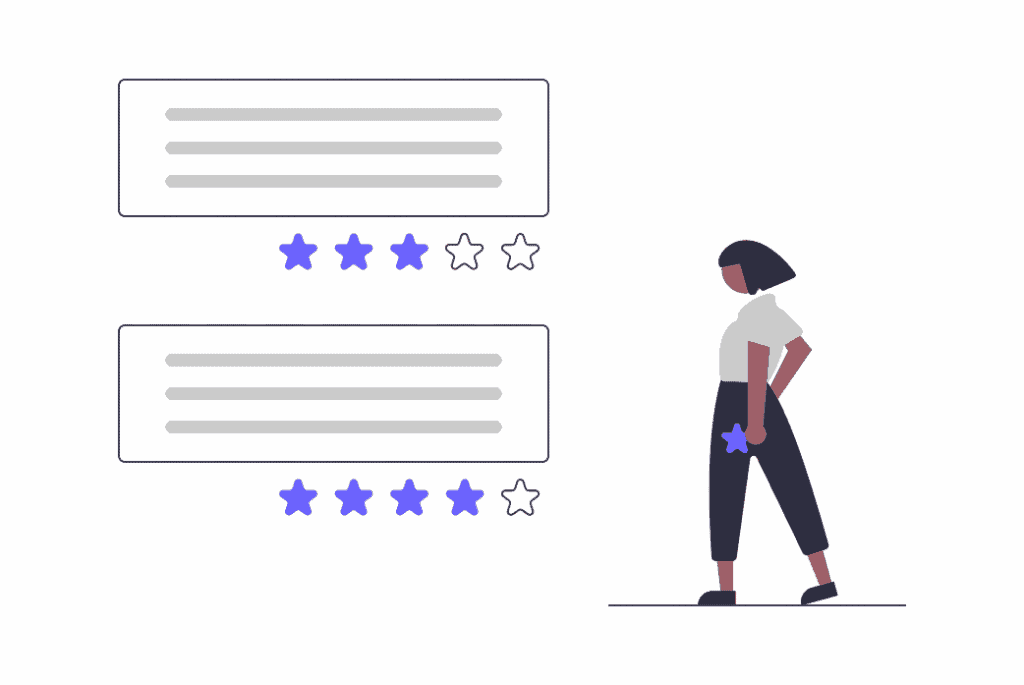
One way to compensate for the lack of trust by potential customers can be the presence of positive opinions from customers who have completed purchases to their satisfaction.
Create an ecommerce website: how to start from scratch
In this section we will focus on the basic steps you will need to go through to create an ecommerce site. We will then look at how to choose the platform and domain name for your online sales site.
As you can imagine, the choice of platform hosting and domain is a mandatory step if you want to understand how to create a website and not only an ecommerce site. However, as we shall see there are platforms designed precisely to create sites for online sales.
Next we will focus on a fundamental aspect on how to optimize the ecommerce from an SEO perspective.
If, on the other hand, you want to deepen the preliminary aspects such as budget, tax and legal obligations of the online sales business, read our guide on ecommerce.
Choose the right platform to create an ecommerce site
The first thing you need to do to create an ecommerce site is to find the platform that best suits your needs. As you may already know there are several ecommerce platforms that you can use to create your website. Let’s assume that there is no one platform that is better than the other, but the choice depends on your specific ecommerce.
In this part of our guide we will see an overview of the most widely used ecommerce platforms so that you can have a clear idea of which one suits you best.
First, though, let’s clarify what an ecommerce platform is and what it’s used for.
An ecommerce platform is an application that was created to allow sellers to manage their ecommerce independently. To create an ecommerce site you will, in fact, need to develop the front-end and back-end of the site.
The front-end is the part of the site that will be seen by your visitors. The back-end, on the other hand, includes all the functions accessible only to the administrators of a site.

Specifically when we talk about creating an ecommerce site these functions will include managing products, orders, contacts and inventory.
There are essentially two types of ecommerce platforms: open source ones and hosted solutions.
Open source platforms such as Magento, PrestaShop or WooCommerce feature open code software, often available for free.
Be careful because using open source software to create an ecommerce site does not mean you can create an ecommerce site for free. Your project will, in fact, need a space on the web for visitors to reach your site. This means that you will need to choose a hosting to host your website.
Hosted solutions, on the other hand, solutions such as Wix or Shopify, provide monthly subscription plans that allow you to use the platform and the services you need to create an ecommerce site and bring it online (server usage, updates, security, and so on).
WooCommerce

WooCommerce is not a stand-alone platform, but a WordPress plugin.
From the statistics of buildwith 33% of ecommerce stores in Italy and 28% worldwide use WordPress + WooCommerce.
WooCommerce is a self-hosted solution, meaning that you will need to choose a hosting service from a provider, such as a WordPress hosting in order to create an ecommerce site.
What makes this solution one of the most widely used? Let’s take a look at the main pros and cons of WooCommerce.
Create an ecommerce website with WooCommerce: the pros
You have the ability to take advantage of all WordPress plugins as well as plugins designed specifically to work with WooCommerce. (For example, you can create a custom WooCommerce login page.)
It’s a great solution to integrate a blog into your ecommerce.
Simple to use, plus, you have an advantage if you already have a site with WordPress. If you’re a beginner, you’ll find plenty of guides and tutorials to help you get to grips with WordPress. In addition to an entire online manual, you have the WordPress codex.
There is no limit to the number of products you can manage. Are you worried that the performance won’t live up to your expectations? Check out my article to understand how important the number of products is on the WooCommerce performance.
As far as payments are concerned, WooCommerce is integrated with several gateways like PayPal, Stripe, Amazon Pay and so on. Also by creating an ecommerce with WooCommerce you can enable recurring payments with an extension like WooCommerce Subscription.
Create an ecommerce site with WooCommerce: the cons
As we said before, WooCommerce is not a standalone platform and cannot be untethered from WordPress.
Since WordPress wasn’t created to allow online sales, WooCommerce’s functionality is limited. There is the ability to extend functionality with extensions and plugins that integrate with WooCommerce, but in some cases you may want to use platforms designed specifically for creating ecommerce sites.
As I said at the beginning when we talk about how to create an online sales site, we can’t give a one-size-fits-all answer as to which is the best platform, but the choice depends on your specific needs.
Shopify

Shopify is used by about 20% of sites worldwide and 9% of sites in Italy. It is a fully hosted platform which therefore also includes the hosting service.
For the design of your ecommerce you can bet on the choice of a template from a nourished catalogue that ranges from free to paid themes. Alternatively, you can also create a new theme with the Shopify theme language (Liquid) even starting from a basic theme as a reference.
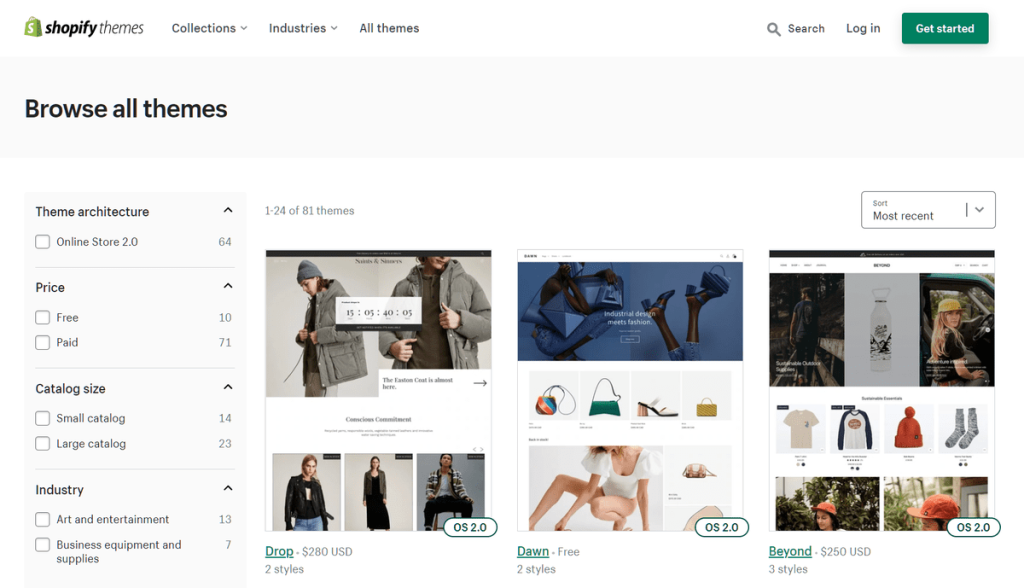
Regarding ecommerce management you can manage orders, shipments, payments and analyze the performance of your business directly from one platform.
Plus, additional apps are available for functionality that is not already integrated, ranging from inventory management to email marketing tools.
Creating an ecommerce site with Shopify: the pros and cons
Among the advantages of Shopify, we can’t not stress enough on the fact that it’s super easy to use. This platform is truly designed for everyone and includes many native features that can be extended with additional apps, often from third parties.
With Shopify Payments, you can accept credit card payments. In addition, you can also allow customers to pay with over a hundred third-party payment processors such as PayPal or Apple Pay. Note that in this case you will be charged commissions for each transaction. Commissions vary based on the plan you choose to use, we’ll talk about that later when we look at how to create an online sales site with Shopify.
As for the internet domain, when you register with Shopify and create your new store, you are provided with a free domain like this one:
store-name.myshopify.com
You can also use a custom domain. In this case you must register a new domain and use it as the domain for your ecommerce site. Remember that each domain is unique and to register it you must make sure that it is among the free domains.
How to create an online sales site with Shopify
You can try Shopify for free for 14 days, after which you can choose one of the three plans available.

Basic Shopify: is the basic plan indicated to start creating an ecommerce site, it has a number of staff accounts or people with access to the management panels limited to 2. This plan does not provide reports and does not allow you to customize prices with different currencies. The cost is 27 euros per month.
Shopify: the intermediate plan, in addition to the basic features includes a reporting system, the number of account staff increases to 5 and payment fees are less expensive. In addition, you can set international prices. The plan costs 74 euros per month.
Advanced Shopify: allows you to have up to 15 staff accounts, you have access to an advanced reporting system and you can set specific prices based on the area where the product is sold. You can also set up a store with 8 inventory locations, while the Basic plan allows for up to 4 and the Shopify plan up to 5.
Then there’s another option given by Shopify Lite a plan that doesn’t include the website and hosting, but allows you to turn an existing website into an online sales business. You’ll be able to accept payments, manage products, orders, inventory and so on for £10 a month.
Not sure if Shopify is the right choice for you? Read our Woocommerce vs Shopify comparison.
PrestaShop

PrestaShop is an open source platform launched in 2007. It is a solution designed to create from scratch and intuitively an online sales site. One of the main advantages of the platform is how easy it is to use even for those who have never approached the creation of websites and have no programming knowledge.
These are two essential factors that allow PrestaShop to appeal to any type of user, but they are not the only advantages of the platform. Let’s take a look at some of the basic features and what the possible limitations are.
Among the platform’s strengths is the availability of advanced features already built in including tools for email marketing management and order tracking. The functions not included by default can be extended by installing the forms (often for a fee) available.
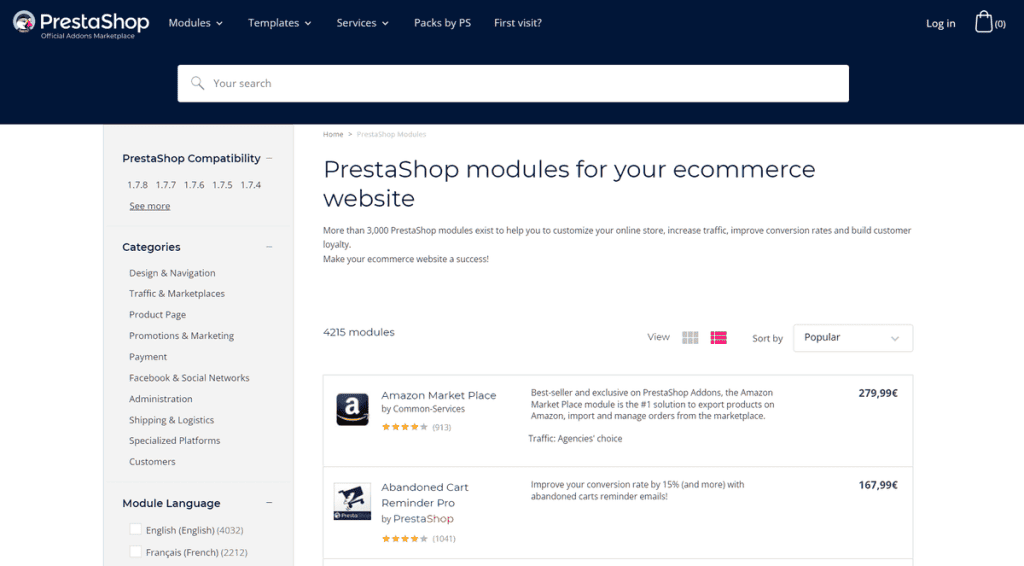
PrestaShop’s PrestaShop Checkout interface allows you to accept a variety of payment methods including credit cards and PayPal. This integrated interface allows you to customize payment systems, provide validation of customer information (to avoid typos), and manage refunds. Note that transaction fees depend on the type of payment used and the country.
As far as customization is concerned there is a lack of free themes. In the absence of free themes for PrestaShop there is no other solution but to look at what is offered by the marketplace of the platform or even other third party marketplaces such as Themeforest if you do not want to settle for the basic theme and customize that.
Create ecommerce site with PrestaShop
Since it is an open source platform, one of the advantages is that you can start trying out PrestaShop’s features for free. You can also test the demo available on the site to try out the most common features.
Then you can launch your ecommerce. Remember that the platform is free, but to bring your project online you will need a hosting service to have a web space for your site. Mainly there are two ways you can choose:
- opt for a shared hosting and install PrestaShop in just a few clicks thanks to a self installer like Softaculous
- choose a PrestaShop hosting and have the platform ready to use.
Magento

Magento is an open source CMS born in 2008 and designed to create ecommerce sites. It is currently used by about 9% of online sales sites, according to data from Buildwith based on the analysis of one million websites.
When we talk about Magento we talk about one of the most complete platforms to create ecommerce site. Among the advantages of the platform there is also the ability to manage multiple online stores through a single administration panel.
All features that are not natively integrated into the platform can be compensated for through extensions that you can find on the dedicated marketplace.
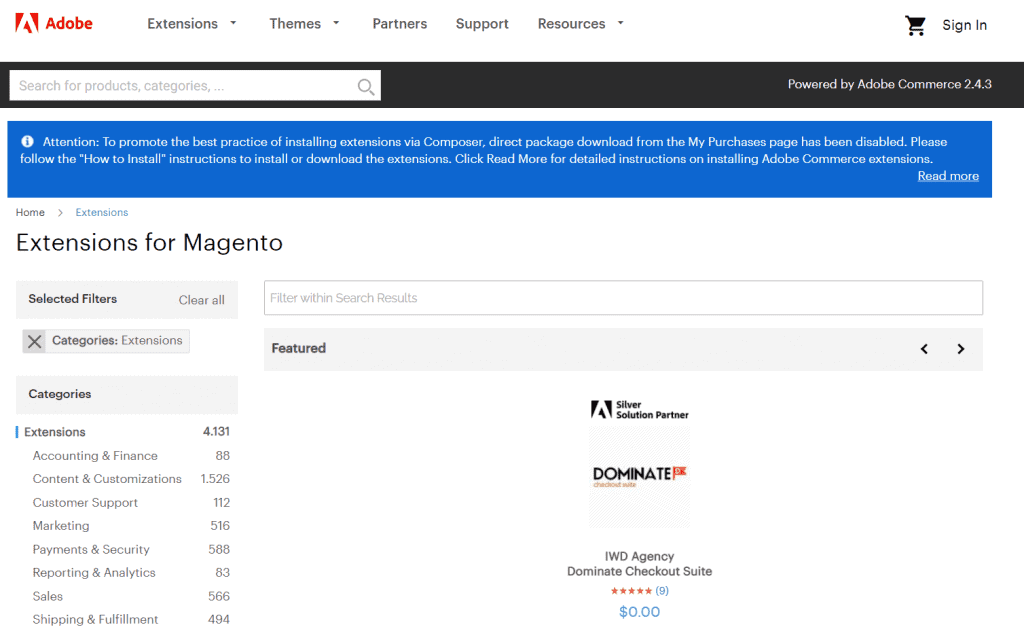
Other features include the ability to manage access to the administration panel, marketing features already integrated including the management of abandoned carts, the ability to take advantage of advanced tools for SEO.
On the other hand, Magento configuration and management are more complex than platforms designed to allow anyone to create an ecommerce site. You can count on a large community and forums dedicated to the platform and rely on industry professionals to create the online store of your dreams.
Create ecommerce site with Magento
As we have seen with other self-hosted platforms, even choosing to create an ecommerce site with Magento you will need a hosting. In this case the choice of hosting is even more important since the hardware requirements of this CMS are quite high, especially with Magento2.
For example in our plans Magento hosting we suggest
a VPS cloud or a dedicated server to ensure maximum performance at all times.
Wix

In this section we’ll talk about Wix and its features for creating an ecommerce site. You can also learn more about the key features of the platform in our comparison Wix vs WordPress.
Wix is a website creation platform that also provides you with a hosting service. In many ways its basic features overlap with those of Shopify.
Keep in mind, however, that Shopify was created as a specialized platform to create an ecommerce site, while Wix has a more generalist character.
Wix allows you to pay by credit card, PayPal and external systems. The Wix Payments service also allows you to manage orders and accept payments by paying a commission for each transaction.
One of the main advantages of Wix is the ease of creating a website. With Wix Editor you create your website from a basic template that you can easily customize using drag & drop.
You can also use Wix ADI and create your site automatically by simply answering a questionnaire.
After creating the skeleton of your ecommerce you can expand the functionality with the apps that you find in the Wix AppMarket.
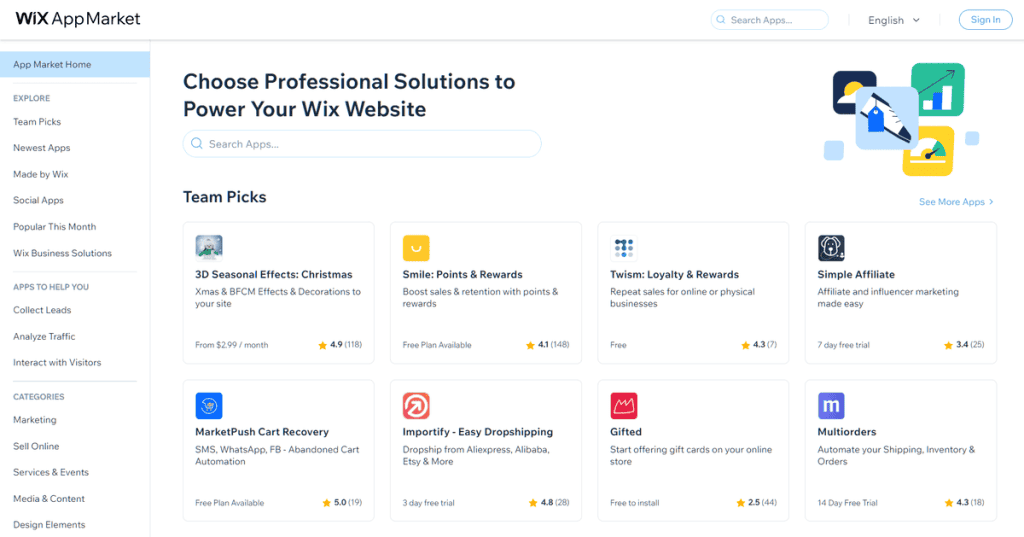
Among the functions offered by Wix it is worth mentioning the possibility of earning online from selling on social channels (all business plans) and to integrate selling on marketplaces (unlimited business and VIP business plans). Let’s take a closer look at the plans available for online sales.
Create an ecommerce website with Wix
If you’re already familiar with Wix, you may be wondering how to create an online sales site with this service. Wix provides dedicated plans for those who want to create an ecommerce site.
There are three plans: business basic, unlimited and VIP. With each plan you can accept online payments with secure methods, remove WIX’s proprietary ads and attach a custom domain. You also get a voucher for a free domain for one year.
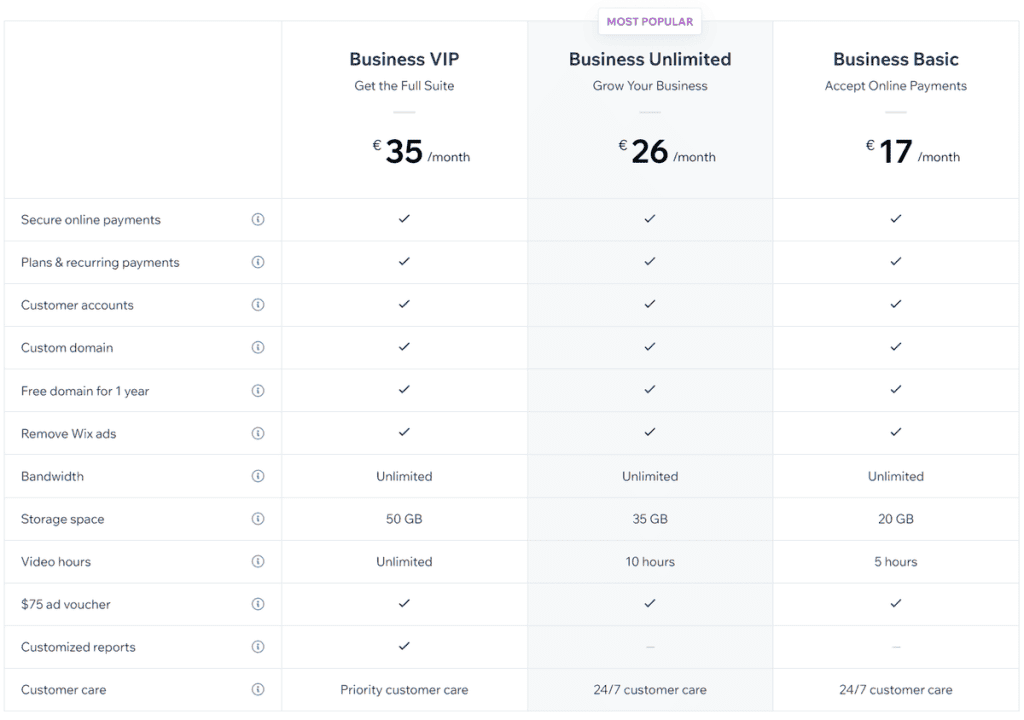
Wix ecommerce plans have no limitations on the number of products, all plans allow you to sell on social channels and you can always set up automated emails for abandoned cart recovery.
Some features, however, are only available with the unlimited or VIP plan, such as:
- the ability to sell subscription services and receive recurring payments
- be able to show prices in different currencies
- sell on marketplaces
- dropshipping
- create custom reports (only available with the VIP plan)
- get priority assistance (VIP plan only).
BigCommerce

BigCommerce is a platform designed for businesses of a certain size (medium and large companies) and it’s not suitable for those who are taking their first steps in the industry or run a small business.
The platform offers advanced options to create ecommerce site and does not lack complex features. However, this results in a greater difficulty of use, compared to platforms that although more limited are within the reach of anyone.
Key features include:
- the ability to manage multiple stores using a single management panel
- the possibility of multi-channel sales: such as sales through social networks and marketplaces
- advanced SEO features
- You can accept payments in over 100 currencies and a variety of payment methods.
Create an ecommerce site with BigCommerce
BigCommerce is a fully hosted platform and allows you to choose from plans available at fixed prices. There is also BigCommerce Enterprise, a tailored plan with variable pricing based on your needs.
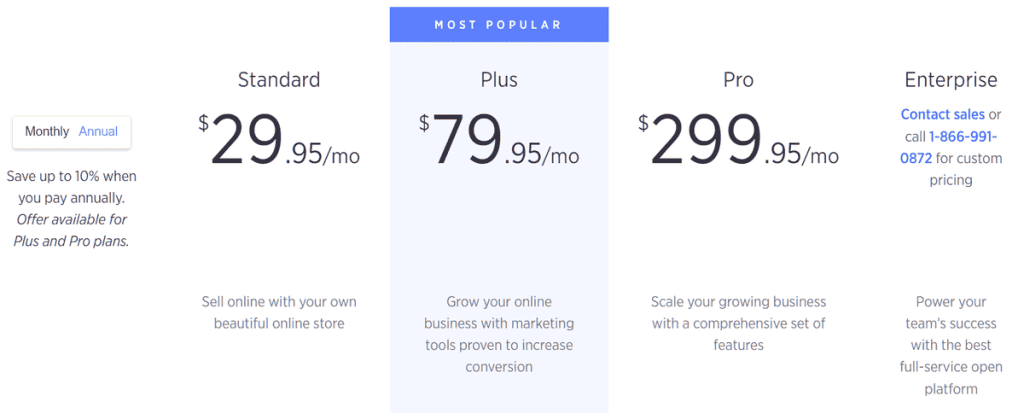
The three main plans are: Standard at $29.95 per month, Plus at $79.95 and Pro at $299.95.
The Pro plan includes all the features and more customization by giving you ways to use a custom SSL certificate, create product filters and show customer reviews on Google.
The Plus plan compared to the Standard plan has some more advanced features like abandoned cart retrieval, cart saving and credit card storage.
To help you choose the plan that best meets your needs, BigCommerce also allows you to take a 15-day free trial.
Volusion

Volusion is a platform that offers a fully hosted service like we have seen for the more famous Shopify or BigCommerce.
One of the features of Volusion is the multi-channel selling capabilities. You can integrate ecommerce with online social selling and marketplace selling.
The platform allows major payment methods such as Stripe, PayPal, Amazon Pay and Apple Pay.
Other benefits of Volusion include an easy-to-use drag & drop editor, and a wide variety of insights and reports to help you grow your online store. Plus you have the ability to sell subscriptions and accept recurring payments.
The main drawbacks include the lack of tools to create a blog section on the site and the fact that you can’t sell digital products. Also, Volusion does not include a free SSL certificate.
Create ecommerce website with Volusion
To start creating an ecommerce with Volusion you can choose one of the available plans: Personal, Professional and Business. In addition to these, you have the Prime plan that is structured according to your needs.
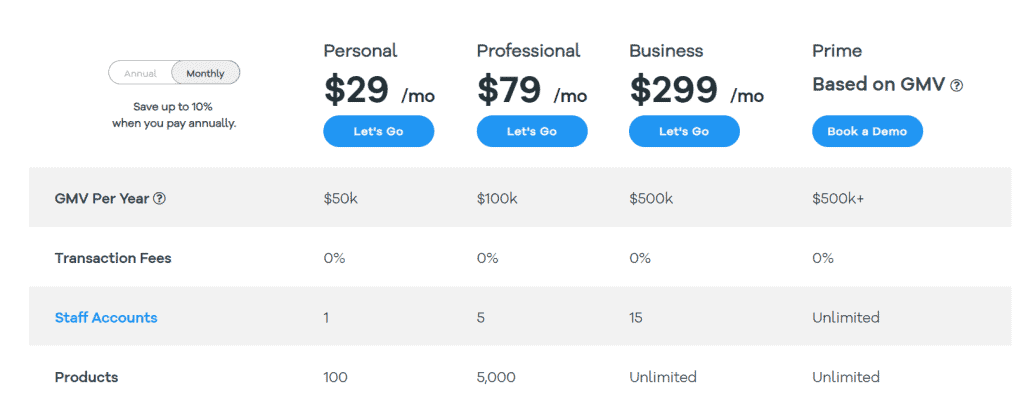
Differences between services include the number of products and staff accounts, priority of access to customer support, and other features such as the ability to view reports on abandoned carts.
The Personal plan at $29 per month allows you to create an ecommerce site for up to 100 products and have one staff account.
The Professional plan at $79 per month allows for up to 5 thousand products and up to 5 staff accounts. With this plan you can also take advantage of additional features such as viewing reports for abandoned carts and using a tool for ratings and reviews.
The Business plan costs $299 per month, this allows you to list unlimited products and have up to 15 staff accounts. With the plan, you get access to full functionality, for example you can integrate your ecommerce to marketplaces like Amazon and eBay and access more detailed analytics.
Choose the domain
After choosing the platform that’s right for you, the next step is to choose the domain name.
The domain will be what your potential customers will type in to link to your site and is therefore one of the aspects of your ecommerce that you should not underestimate.
Note that some platforms allow you to have a free domain associated with your ecommerce. In these cases, the domain will also contain the name of the platform and will look like this:
your-shop.myshopify.com
To create a professional looking ecommerce site, it is suggested you purchase a custom domain of the type:
yourshop.com
The choice of domain name for an ecommerce store generally falls into two main branches. On the one hand there are those who use the brand name for the domain (e.g. eBay, Amazon). On the other hand, you can also aim for a more descriptive domain name that immediately recalls the products you sell.
A widely debated issue concerns the use of keywords in the domain name. The dry keywords inserted in the domain can affect the ranking in the search engines?
Until a few years ago, there was a huge spread of what are called exact match domains. However, starting in 2012, Google’s EMD algorithm turned the tide.
The update of the algorithm in fact penalized sites that use dry keywords in the domain and do not contain relevant content and quality.
Create an ecommerce website: SEO optimization
You’ve probably heard by now that SEO optimization of an ecommerce is crucial if you want your site’s visibility and conversions to increase. But why?
To understand the reason for this, we need to know what are the major sources of traffic for an ecommerce.

An analysis conducted by Semrush revealed that 49.3% of visits come from direct traffic.
This means that users link directly to the ecommerce address. However, this can only happen when the visitors are regular customers who already know the site in question.
The most immediate example is a customer who logs into Amazon to make a purchase.
It is interesting to note, however, that 37.5% of visits are represented by organic traffic. A good part of the visits, therefore, comes directly from searches on search engines. It is possible to increase organic traffic by scaling search engine results.
The remaining percentages of traffic come from referral traffic, which are backlinks that come from other websites, social and paid campaigns.
This data suggests that before you can get a large volume of traffic through direct traffic, one of the most effective methods is to focus on organic traffic, and then on SEO.
SEO for ecommerce, where do I start?
What are the highlights of an SEO strategy to create a successful ecommerce site?
Basically, we have to keep in mind the rules that apply on every site, but there are also some aspects that specifically specifically the online sales sites. So let’s see them one by one, by starting with keyword research.
Keyword Search
Like any SEO strategy, optimizing for an ecommerce site must start with keyword research. Let’s take a look at what tools to use for keyword research and how to choose the right ones for your ecommerce.
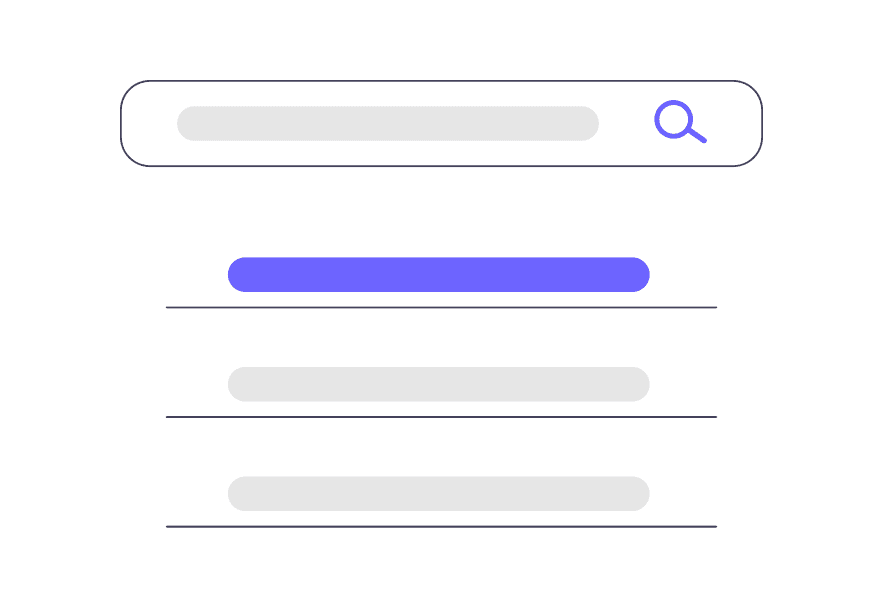
SEO tools for keyword research
You can leverage SEO tools not only to find keywords that are inherent to your industry, but also to discover their search volumes.
These tools are also useful to know the competitiveness of keywords, sometimes also referred to as keyword difficulty or competition.
In general, short-tail keywords are the most generic and the most competitive. Long-tail keywords, on the other hand, will be easier to position because they are much more specific.
In addition to keyword research, with tools like Google Keyword Planner, Ubersuggest, Ahrefs, SEMRush and so on, you can take advantage of two other interesting sources.
The first is Google Suggest, which are the related searches that you find at the bottom of the search engine page after performing a search and that appear while you’re typing in the search bar.
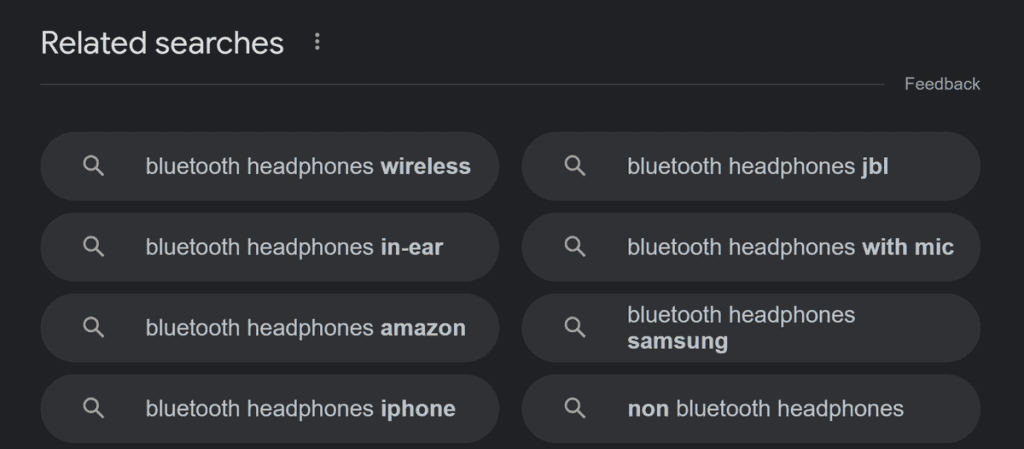
Related searches are designed for the user to help them learn more about a topic or find related queries. For your part, you can use them to get keywords related to a main keyword.
You can get the keywords used in Google Suggest with a tool like Keyword Tool or Keyword Tool Dominator. Both tools allow you to get suggestions from search engines and other sites that you can use to your advantage.
Keyword Tool allows you to get the list of keywords and export them to a csv file or directly to Excel for free. In order to get information such as search volume and keyword competitiveness you need to use the pro version.
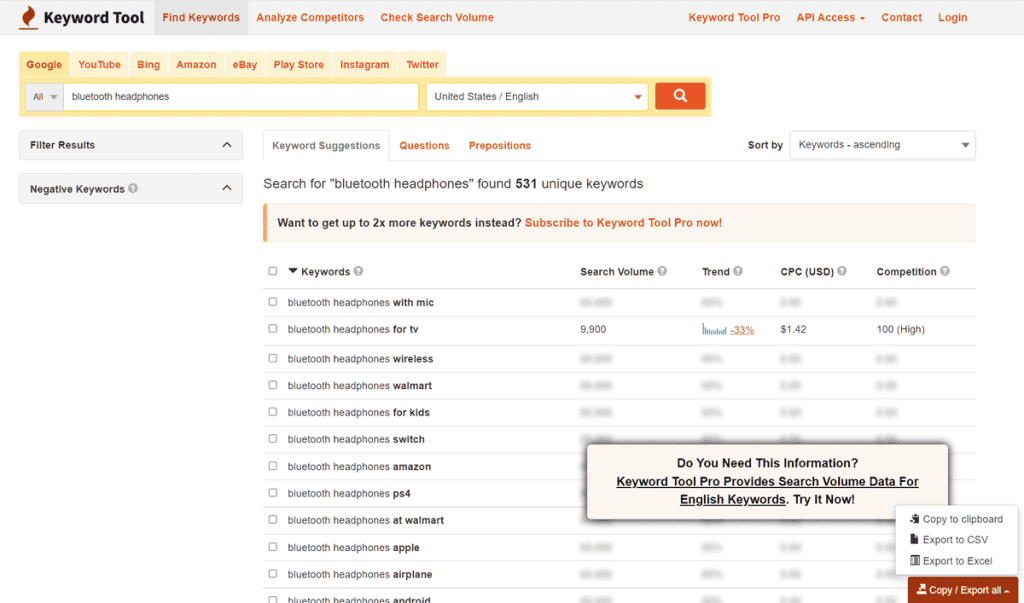
Another valid source fo assistance is given by the search suggestions of the most famous ecommerce in the world: Amazon. When you type the keywords you are interested in into the Amazon search bar, a series of the most searched phrases will appear, allowing you to refine your search.
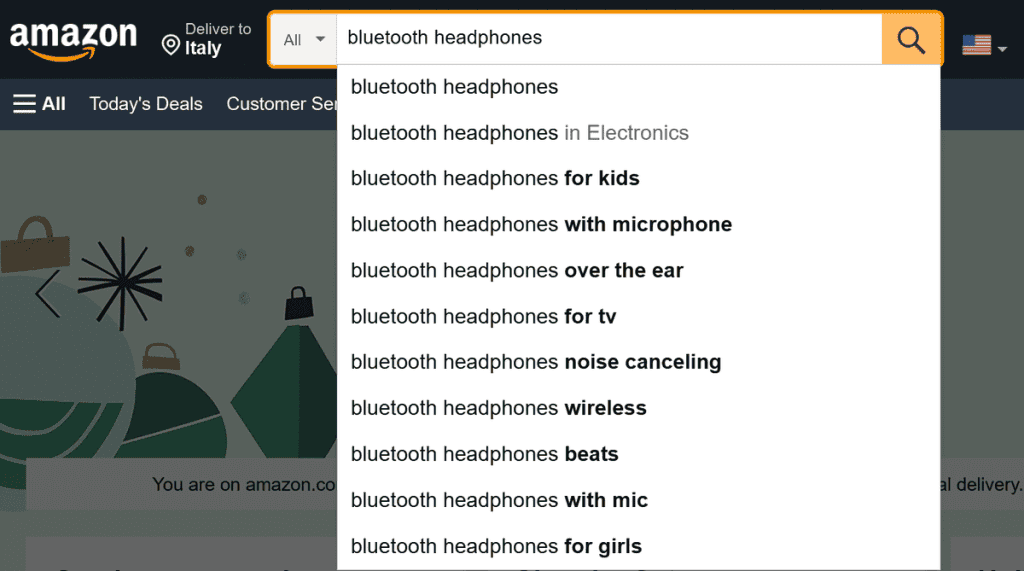
To simplify keyword research based on Amazon’s suggestions you can also use a tool like the Amazon Keyword Tool Keyword Tool Dominator.
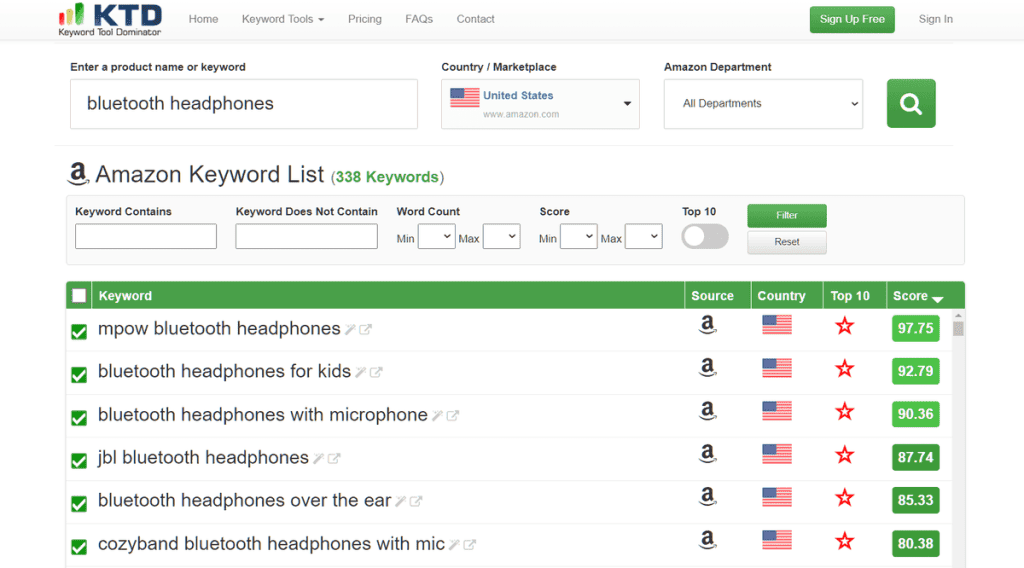
In the free version you can perform a maximum of two searches per day, before upgrading to a paid (lifetime) plan.
Choose the most suitable keywords
Now that we’ve come up with a list of keywords, we still don’t know exactly which ones may have the best result for our ecommerce.
In order to get going, you just need to keep a few basic points in mind.
First look at the search volume, it doesn’t make sense to target keywords with low or no searches.
Exclude, therefore, all those that have a too low search volume. When making these evaluations, keep in mind that the more your industry is a niche, the lower the volume will be.
Don’t use keywords that are not relevant to your business. Remember your goals: create an ecommerce site, increase organic traffic and increase conversions.
Don’t be tempted by a keyword with a high search volume that deviates too much from the products you sell on your ecommerce. Remember that keywords serve you to intercept the search intent of users.
That means your goal is really to leverage them to find potential customers interested in what you’re selling. Attracting users looking for something they won’t find on your site isn’t forward thinking and won’t help your online sales.
Create an ecommerce website: text optimization
After collecting the keywords related to the online sales sector you want to focus on, it’s time to put the keywords in the right place.

If your goal is to create an ecommerce site that works, the pages you’ll need to take care of the most are the categories and product pages.
Page title and description
Each page should have the main keyword in the title tag, which is the header that will be shown in the SERP, and in the main header tags. If you are not familiar with these tags you can check our article on how to use tags h1, h2 and h3.
You can also make the title tag more appealing and try to respond to the search intent by adding more terms to the keyword you want to rank for.
For example if your keyword is “sport bluetooth headphones” you can add words like:
- Buy
- Free shipping
- Free return
- Best
- Cheap
- Offer.
Similarly, the meta description of the page should also contain the keyword. Even if the meta description is no longer a ranking factor, creating ad-hoc text can make a difference in how much a result is clicked on or not by the user. In other words, it has a bearing on CTR.
In the meta description, as we have seen for the title, you can include useful information and attract the interest of users. For example, you could invite them to discover the details of an offer or specify that every order includes free shipping.
Tip: You can integrate ChatGPT with WordPress to quickly generate meta descriptions for your products.
Product descriptions and categories
In addition to focusing on how the page will appear in search results, a key step in creating an ecommerce site will be creating product pages and categories.
Category pages typically have a short introductory description to talk about the products that are part of that section. The purpose of category pages is to link to subcategories or directly to products.
In some cases, in addition to the photo and name of the product, you can choose to include a brief description of the individual products.
Of course the elements that need to be optimized will be the headers and the text.
Now let’s move on to another important section of our ecommerce, the product descriptions. Again, SEO plays a key role so make sure you include the keywords you want to focus on.
The density of the keyword should depend on the length of the description itself. As far as possible it is good to use the keyword at the beginning of the text.
Remember that in the product pages it will be important also to carefully choose the images and optimize them, you can check our guide on how to optimize SEO images in order to know where to start.

Keep in mind also that the photos should have a good resolution, but do not exaggerate if you do not want to give up having a fast site.
Create ecommerce site: the architecture of the site
As we have seen in our guide on how to run an ecommerce site. SEO analysis, the site architecture is important for any type of website, it becomes even more important when we talk about an ecommerce site because of the exorbitant number of pages in these type of sites.
The structure of an ecommerce site is represented by categories and subcategories to get to individual product pages.

To make search easy for both users and bots, the page hierarchy should consist of up to three levels.
The main categories should be linked directly to the home page. Then each category will branch into subcategories and finally at the third level you should have the products. In this way from the home page you can get to the products page in three steps.
To ensure navigation within the site you will need to structure the menus in the same way.
Ecommerce, URLs and duplicate content
Remember to use a simple structure for URLs as well. On an ecommerce site you will have longer URLs than on other sites because of the more complex structure of the site itself.
The typical URL of an ecommerce will have this structure:
https://site.com/namecategory/nameundercatergory/name-product
To ensure that the URL does not become too long due to the amount of information it contains, try to use one or two words maximum for categories and subcategories. Also avoid product IDs and other references that can unnecessarily lengthen URLs.
Note that some ecommerce sites do not include categories and subcategories in their URLs, which will then look like this:
https://site.com/nameofproduct
Depending on the structure of the ecommerce site, some products may fall into different categories and therefore be accessible from different URLs. Keep in mind that search engines consider each unique URL as if it were a separate page.
How to avoid duplicate URLs in an ecommerce?
The canonical rel tags which allow you to tell the bots which pages are to be considered main and which are to be excluded from indexing. You can check that you have correctly set the canonical tags in the list of excluded pages by using Google’s Search Console.
Conclusion
In this article, Create an commerce website:the complete guide, we have seen the basic steps to follow to create an ecommerce site. After seeing the reasons to venture into online sales, we saw what we needed to create the site, how to choose the platform to use and how to choose the domain.
In the second part of this guide, we focused on the practical aspects of building your site and saw what factors to take into account to optimize your ecommerce. Have you already chosen the platform to use and started creating your ecommerce site? Let me know in the comments below.



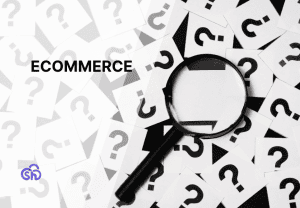
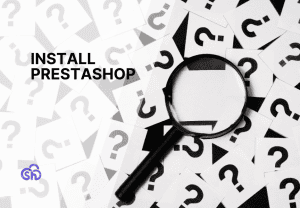
Leave a Reply